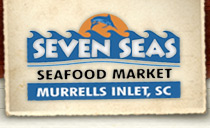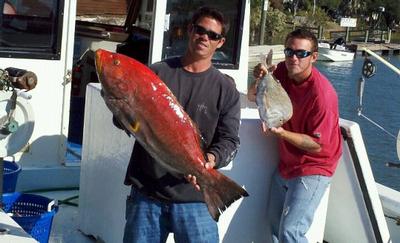

Recent Posts
Murrells Inlet fishing community celebrates life of pioneer who passed unexpectedly
Posted: October 23, 2019 11:48 AM
Commercial Fisherman Feel Effects of Fishing Ban
Posted: February 21, 2012 5:20 AM
Seven Seas Sponsors Community Oyster Roast
Posted: January 23, 2012 7:53 AM
Chris' Opinion Published in The Sun News
Posted: October 18, 2011 8:13 AM
Captain and Crew of F/V CJR Rescued By Coast Guard
Posted: January 25, 2011 6:16 AM
Chris Published in the "Weekly Surge"
Posted: January 7, 2011 11:38 AM
Run Away Boat Causes Captain to Fish over Christmas Holidays
Posted: December 7, 2010 3:55 AM
Catch Share Fishing Plan Needed
Posted: November 30, 2010 8:06 AM
 Back
Back
Commercial Fisherman Feel Effects of Fishing Ban
Posted By: Chris Conklin | February 21, 2012 5:20 AM

Gregg Holshouser outdoors column | Commercial fishermen feel effects of ban
The plight of recreational anglers during the first four to five months of each calendar year has been well documented, with practically the complete abolition of bottom fishing in the Atlantic Ocean along the Southeast Coast from January through April.
Without quite as much fanfare, local commercial fishermen who ply their trade the old-fashioned way – by hook and line – to provide fresh locally caught fish fight their own battles to keep their businesses afloat.
Like the recreational angler, commercial fishermen face two big closures that include critical fish they target, severely limiting their catch during the first four to five months each year. A spawning season closure for shallow-water grouper runs from January through April and the black sea bass fishery is closed based on a quota that is quickly reached after the official fishing season opens on June 1.
Grouper and black sea bass are perhaps the most desired locally caught fish on the market but their availability has been severely limited since July 2009 when a suite of management measures contained in Amendment 16 to the Fishery Management Plan for the Snapper-Grouper Fishery of the South Atlantic Region went into effect.
In 2011, the commercial black sea bass fishery opened on June 1, but the South Atlantic Region’s quota of 309,000 pounds was met in only a month and a half, quickly closing the fishery on July 15. The fishery has been closed ever since and won’t reopen until June 1. That means a critical commercial species locally was available for only 1=BD months of the fishing during the calendar year for black sea bass.
Shallow-water grouper, including gag, red and scamp among others, are very good table fare and bring an excellent price on the market, but their availability for commercial anglers in the South Atlantic Region (from Cape Hatteras, N.C., to Key West, Fla.) is restricted by a spawning season closure and quotas.
First there is the annual spawning season closure from January through April, and the annual commercial harvest quota, or Annual Catch Limit. Now, there is also an aggregate commercial Annual Catch Limit, or quota, for gag, black grouper, and red grouper of 662,403 pounds.
If either of these Annual Catch Limits is met or projected to be met, the commercial possession of all shallow-water grouper will be prohibited for the remainder of the fishing year. So with two critically important reef species currently off limits, what are the local commercial anglers targeting?
The short-term answer has been three species: vermilion snapper, triggerfish and golden tilefish. But two of those species will soon be closed to harvest, too.
The harvest of the deep-water golden tilefish is prohibited starting today after the species’ commercial quota was met.
Vermilion snapper, locally called beeliners, are the main species local commercial boats have been harvesting in 2012 with triggerfish as an excellent by-catch. But the quota for vermilion snapper is looming, and Phil Conklin, owner of Seven Seas Seafood in Murrells Inlet, thinks the closure of the species will happen sooner rather than later.
The vermilion snapper is the staple catch for local boats, and has become a derby fishery where commercial boats race to bottom spots to get their piece of the quota before it is caught.
“I don’t believe the beeliner quota is going to last too much longer,” said Conkin, who with his son, Chris, operates 13 commercial boats out of Murrells Inlet and Georgetown. “It’s hard to make a living, I mean you can break even and make a little bit of money catching 1,500 pounds of beeliners a trip. But other than that, once this happens, once this closure (on vermilion snapper) comes ....”
Conklin’s voice trailed off, and Chris continued.
“In a couple of weeks it’s going to be kind of scarce until May,” said Chris Conklin.
Once vermilion snapper are closed, that leaves triggerfish and amberjack as potential species for commercial boats to harvest until grouper are again fair game on May 1. But amberjack aren’t preferred as table fare in the local area and triggerfish aren’t available in prolific enough numbers to justify a commercial fishing trip.
“We’ve got plenty of (fresh local fish) now, and we’ll have some all the way up until they shut the (vermilion) snapper fishery down,” said Phil Conklin, who opened Seven Seas 26 years ago. “Then we’ll have certain amounts of local fish but we won’t have any production. Your by-catch of triggerfish, it’s an excellent fish but … it’s not worth going fishing to catch triggerfish unless they’re just crawling up the line. Basically it doesn’t pay to crank the boat up except to run it just to run the engine. It isn’t worth making a fishing trip. it will be tough until the first of May when things will start picking up for us.”
The lack of availability of local fish forces the Conklins to look for alternate means of providing fish, and making money.
They provide regional fish such as grouper, red snapper and pompano caught in the Gulf of Mexico, striped bass from the Outer Banks and Chesapeake Bay area, cod from the Northeast and flounder from the Carolinas.
They will also open a live online market in March at www.sevenseasseafood.com.
“It’s really tough, it’s getting harder and harder to survive,” said Chris Conklin. “We’re not crying the blues but the industry is going downhill. We’ve got to do some thinking outside the box during these times.
It’s not a hobby for us, it’s our job and we care about the resource. We like to think we are stewards of the resource.”

